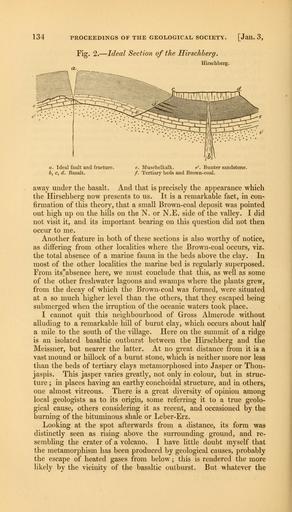MAKE A MEME
View Large Image

| View Original: | The_Quarterly_journal_of_the_Geological_Society_of_London_(12711403255).jpg (1828x3200) | |||
| Download: | Original | Medium | Small | Thumb |
| Courtesy of: | commons.wikimedia.org | More Like This | ||
| Keywords: The Quarterly journal of the Geological Society of London (12711403255).jpg 134 <br> PROCEEDINGS OF THE GEOLOGICAL SOCIETY Jail 3 <br> Fig 2 Ideal Section of the Hirschberg <br> Hirschberg <br> a Ideal fault and fracture <br> b c d Basalt <br> e Muschelkalk e' Bunter sandstone <br> / Tertiary beds and Brown-coal <br> away under the basalt And that is precisely the appearance which <br> the Hirschberg now presents to us It is a remarkable fact in con- <br> firmation of this theory that a small Brown-coal deposit was pointed <br> out high up on the hills on the N or N E side of the valley I did <br> not visit it and its important bearing on this question did not then <br> occur to me <br> Another feature in both of these sections is also worthy of notice <br> as differing from other localities where the Brown-coal occurs viz <br> the total absence of a marine fauna in the beds above the clay In <br> most of the other localities the marine bed is regularly superposed <br> From its absence here we must conclude that this as well as some <br> of the other freshwater lagoons and swamps where the plants grew <br> from the decay of which the Brown- coal was formed were situated <br> at a so much higher level than the others that they escaped being <br> submerged when the irruption of the oceanic waters took place <br> I cannot quit this neighbourhood of Gross Almerode without <br> alluding to a remarkable hill of burnt clay which occurs about half <br> a mile to the south of the village Here on the summit of a ridge <br> is an isolated basaltic outburst between the Hirschberg and the <br> Meissner but nearer the latter At no great distance from it is a <br> vast mound or hillock of a burnt stone which is neither more nor less <br> than the beds of tertiary clays metamorphosed into Jasper or Thon- <br> jaspis This jasper varies greatly not only in colour but in struc- <br> ture ; in places having an earthy conchoidal structure and in others <br> one almost vitreous There is a great diversity of opinion among <br> local geologists as to its origin some referring it to a true geolo- <br> gical cause others considering it as recent and occasioned by the <br> burning of the bituminous shale or Leber-Erz <br> Looking at the spot afterwards from a distance its form was <br> distinctly seen as rising above the surrounding ground and re- <br> sembling the crater of a volcano I have little doubt myself that <br> the metamorphism has been produced by geological causes probably <br> the escape of heated gases from below ; this is rendered the more <br> likely by the vicinity of the basaltic outburst But whatever the 35614706 110213 51125 Page 134 Text v 11 http //www biodiversitylibrary org/page/35614706 1855 Geological Society of London Biodiversity Heritage Library The Quarterly journal of the Geological Society of London v 11 1855 Geology Periodicals Smithsonian Libraries bhl page 35614706 dc identifier http //biodiversitylibrary org/page/35614706 smithsonian libraries Information field Flickr posted date ISOdate 2014-02-23 Check categories 2015 August 26 CC-BY-2 0 BioDivLibrary https //flickr com/photos/61021753 N02/12711403255 2015-08-26 21 00 50 cc-by-2 0 PD-old-70-1923 The Quarterly journal of the Geological Society of London 1855 Photos uploaded from Flickr by FĂŚ using a script | ||||